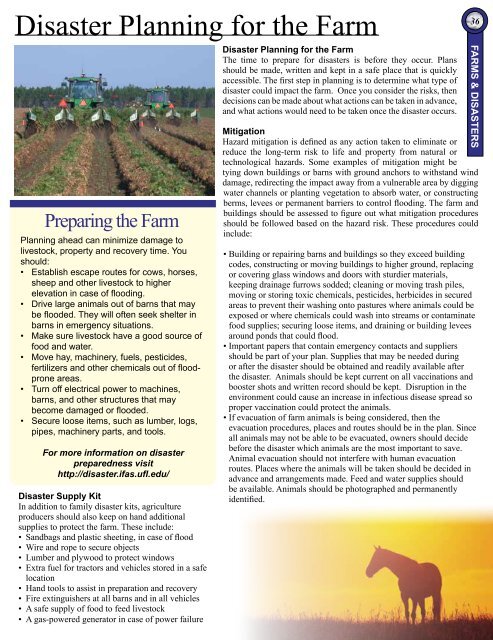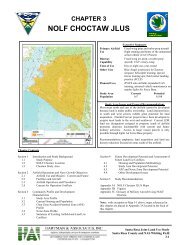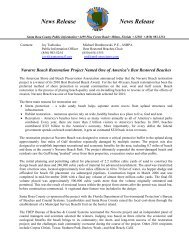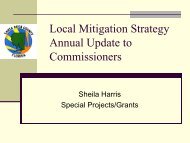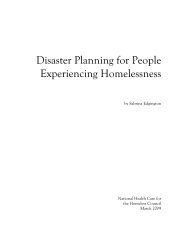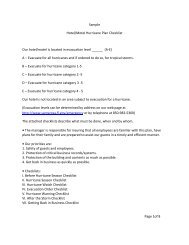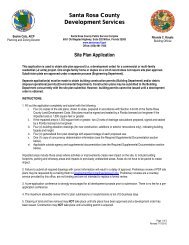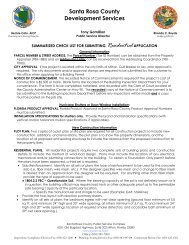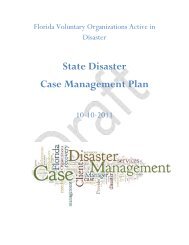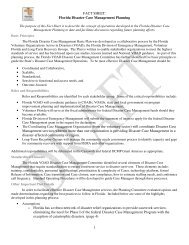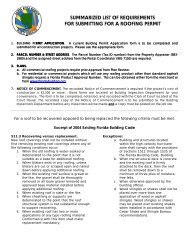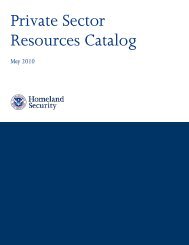Disaster - Santa Rosa County
Disaster - Santa Rosa County
Disaster - Santa Rosa County
You also want an ePaper? Increase the reach of your titles
YUMPU automatically turns print PDFs into web optimized ePapers that Google loves.
<strong>Disaster</strong> Planning for the Farm<br />
Preparing the Farm<br />
Planning ahead can minimize damage to<br />
livestock, property and recovery time. You<br />
should:<br />
• Establish escape routes for cows, horses,<br />
sheep and other livestock to higher<br />
elevation in case of flooding.<br />
• Drive large animals out of barns that may<br />
be flooded. They will often seek shelter in<br />
barns in emergency situations.<br />
• Make sure livestock have a good source of<br />
food and water.<br />
• Move hay, machinery, fuels, pesticides,<br />
fertilizers and other chemicals out of floodprone<br />
areas.<br />
• Turn off electrical power to machines,<br />
barns, and other structures that may<br />
become damaged or flooded.<br />
• Secure loose items, such as lumber, logs,<br />
pipes, machinery parts, and tools.<br />
For more information on disaster<br />
preparedness visit<br />
http://disaster.ifas.ufl.edu/<br />
<strong>Disaster</strong> Supply Kit<br />
In addition to family disaster kits, agriculture<br />
producers should also keep on hand additional<br />
supplies to protect the farm. These include:<br />
• Sandbags and plastic sheeting, in case of flood<br />
• Wire and rope to secure objects<br />
• Lumber and plywood to protect windows<br />
• Extra fuel for tractors and vehicles stored in a safe<br />
location<br />
• Hand tools to assist in preparation and recovery<br />
• Fire extinguishers at all barns and in all vehicles<br />
• A safe supply of food to feed livestock<br />
• A gas-powered generator in case of power failure<br />
<strong>Disaster</strong> Planning for the Farm<br />
The time to prepare for disasters is before they occur. Plans<br />
should be made, written and kept in a safe place that is quickly<br />
accessible. The first step in planning is to determine what type of<br />
disaster could impact the farm. Once you consider the risks, then<br />
decisions can be made about what actions can be taken in advance,<br />
and what actions would need to be taken once the disaster occurs.<br />
Mitigation<br />
Hazard mitigation is defined as any action taken to eliminate or<br />
reduce the long-term risk to life and property from natural or<br />
technological hazards. Some examples of mitigation might be<br />
tying down buildings or barns with ground anchors to withstand wind<br />
damage, redirecting the impact away from a vulnerable area by digging<br />
water channels or planting vegetation to absorb water, or constructing<br />
berms, levees or permanent barriers to control flooding. The farm and<br />
buildings should be assessed to figure out what mitigation procedures<br />
should be followed based on the hazard risk. These procedures could<br />
include:<br />
• Building or repairing barns and buildings so they exceed building<br />
codes, constructing or moving buildings to higher ground, replacing<br />
or covering glass windows and doors with sturdier materials,<br />
keeping drainage furrows sodded; cleaning or moving trash piles,<br />
moving or storing toxic chemicals, pesticides, herbicides in secured<br />
areas to prevent their washing onto pastures where animals could be<br />
exposed or where chemicals could wash into streams or contaminate<br />
food supplies; securing loose items, and draining or building levees<br />
around ponds that could flood.<br />
• Important papers that contain emergency contacts and suppliers<br />
should be part of your plan. Supplies that may be needed during<br />
or after the disaster should be obtained and readily available after<br />
the disaster. Animals should be kept current on all vaccinations and<br />
booster shots and written record should be kept. Disruption in the<br />
environment could cause an increase in infectious disease spread so<br />
proper vaccination could protect the animals.<br />
• If evacuation of farm animals is being considered, then the<br />
evacuation procedures, places and routes should be in the plan. Since<br />
all animals may not be able to be evacuated, owners should decide<br />
before the disaster which animals are the most important to save.<br />
Animal evacuation should not interfere with human evacuation<br />
routes. Places where the animals will be taken should be decided in<br />
advance and arrangements made. Feed and water supplies should<br />
be available. Animals should be photographed and permanently<br />
identified.<br />
36<br />
Farms & <strong>Disaster</strong>s


